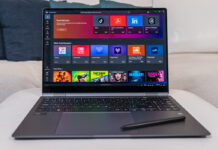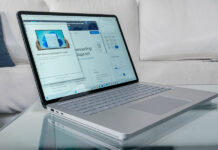![]()
Google’s Pixelbook is a Chromebook venturing into a very different calibre than in the past, and its potential will be rosy for some, unclear for others.
This isn’t a typical Chromebook from two standpoints. First, it’s not using the older Chrome OS that relied heavily on the browser, and second, it brings in Android apps in a way that affects overall usability. Whether that’s positive or negative really depends on what you feel you could accomplish with it, and how patient you are at getting there.
Design
It’s not an exaggeration to proclaim this the most beautiful Chromebook laptop to date. It’s considerably better in a number of facets, with its aesthetic appeal especially standing out. How high or low the bar was up to this point is a matter of debate, but I don’t think I’m overstating the Pixelbook’s visual appeal.
Google designed it to be a convertible 2-in-1, straddling the line between a laptop and tablet. The hinges allow for full 360-degree motion, making it easy to prop up or down in a number of different ways. It’s under a half-inch thick when closed, weighs a lightweight 2.5 pounds and is made of aluminum and glass. What you would think is a delicate combination feels almost ruggedly refined.
The 12.3-inch screen has a resolution of 2400 x 1600, making it more square, with sizeable bezels all around. While there is a 720p front-facing webcam at the top, the rest shows obvious thickness. One advantage to having the larger bezels is that it makes the touch-sensitive screen easier to handle when flipping it over to reorient the device. So, it has a functional purpose, but it’s one aesthetic that could be better for sure.
The keyboard is backlit, and is nicely designed. I thought recessed keys would be a problem, but I grew to really like feel of the keyboard. One of the smartest design choices was using rubberized silicone on the palm rests flanking the touchpad.
Specs under the hood are pretty respectable too. A 7th-gen Intel Core i5 (Kaby Lake) processor with 8GB of RAM and either 128GB or 256GB of internal storage round out a decent package.
![]()
Setup and usability
To get the Pixelbook going took minutes since I only needed to log into my Google account. Some software updates were required, but saving that, there was little to do to get started.
If you have an Android phone or tablet, whatever apps you downloaded via Google Play would be available to re-download onto the Pixelbook. Well, within reason. Not all apps are compatible, and hardware usually determines that. For example, any app that requires using a camera is a non-starter, unless it’s a chatting app, like Skype. Optimization may bring up a roadblock too, which may not be clear as to why.
Other apps will run, yet retain the aspect ratio they typically use on smartphones and tablets. Stretching them out is sort of like rolling the dice because the app may look terrible when resized or outright crash. Developers have to optimize their apps to run on the Pixelbook, and it’s not especially evident that they’re doing so.
Most apps you would expect to work on a laptop are okay though. Microsoft’s Office apps for Android are readily available, as are Adobe’s different photo-editing apps. YouTube works well, Netflix looks fine, Google Maps is laid out well. Some drawing apps have made good on the device’s resolution so far. Time will tell how many others fall in line.
Beyond that, the Chrome browser is always there as an alternative. At least as it relates to apps that have a browser-based alternative. For example, Spotify’s Android app appears in smartphone form, which can be fine because you can overlay it while doing something else, like I did. Or you could simply log in on Chrome and use the full screen that way.
That sort of dynamic is common with the Pixelbook. Chrome OS doesn’t have the desktop app flexibility Windows and MacOS have, so this mishmash of browser and mobile apps becomes equal parts salvation and frustration during usage.
![]()
Pixelbook Pen
The Pixelbook Pen is a dedicated accessory (it doesn’t really work with anything else) that comes separately sold. You won’t find it hidden inside the box somewhere. Its stated purpose is to add an additional input method, while integrating Google Assistant into its one physical button.
For now, the pen has limited range. It’s great for apps like Evernote, Adobe Sketch or Painter, where it feels soft and responsive every time. Google also tried to make it contextually helpful, where Assistant could chime in after you circle a word or passage and click the button.
There’s real potential here, except the pen doesn’t go as far as, say, a stylus does on a Microsoft Surface. The button doesn’t do anything else, and using it to wake up the Assistant was most useful when I had reversed the keyboard to prop up the screen.
![]()
Performance
I came into testing the Pixelbook with some skepticism because I was unsure its price would coincide with its ability to get things done. It took some time, but the device really did grow on me, proving that productivity was indeed possible.
Google equipped it with the kind of specs one should expect in a laptop at this price point. Those specs are somewhat offset by the limited access to intensive applications. For example, you won’t be running Adobe’s Creative Suite on this, though you could settle on the Android app versions. Video editing is probably not going to go all that well, but again, if you can find an Android app, or something that works with Chrome OS, then you could always give it a shot.
I found more success in taking a moderate approach. Microsoft Office apps ran really well, and like I wrote this review on the Pixelbook using Word, I used Evernote to jot down notes along the way during testing. Email was great, as was viewing or editing PDF documents. Online banking or anything I could do through a browser also worked really smoothly.
The file system under the Files app was adequate enough to resemble what a desktop OS looks and feels like, but needless to say, there is an adjustment period to go through. Initially, there is a nagging feeling that something is always missing when using the Pixelbook. Once I found a groove by adjusting to what was available, I got more out of it.
Part of that process was in discovering alternatives. If a desktop app wasn’t an option, then what Android app could step in? If an Android app wasn’t optimized well for the device, was there another one that could take its place more appropriately?
Until more developers embrace Chrome OS, that kind of cat-and-mouse game is likely going to figure prominently with the Pixelbook.
![]()
Media and gaming
I put the 128GB of storage to good use by downloading Netflix shows and movies so I could watch them offline. Though I had to contend with USB-C ports on either side, I was able to use an adapter to plug in an external hard drive to copy over some music and video files. Again, pretty smooth, for the most part.
Gaming was also an interesting experience. I played NBA Live a fair bit, which looked great in full screen, and ran without any lag or framerate drops. Same with other games, like Angry Birds 2 and Asphalt 8.
There were oddities in between, however. The Rogers NHL Live app wasn’t compatible, forcing me to watch through a browser. DAZN was initially unavailable, only to then be available after a software update.
Battery life
Like with most laptops, battery life is dependent on usage habits. I was able to consistently get eight hours per charge with mixed usage. Constant video streaming naturally dropped that down closer to five or six hours. Either way, it’s decent, but hardly exceptional.
The included charger does at least put the Pixelbook back in operation quickly. With a 15-minute charge, I could get up to another two hours of use. I could also plug into either USB-C port to charge, adding a little more convenience.
Final thoughts
Anyway you look at it, the Pixelbook requires patience and a learning curve for Chrome OS newcomers. This is a really lightweight operating system, and truth be told, it feels like it too. The intricacies and depth you typically see in Windows or MacOS aren’t apparent here. Packaging it within an attractive piece of hardware only serves to make the case stronger.
I wouldn’t even consider this device if you are in some form of media editing. The limitations are too constrained for that. For basic productivity, with plenty of room for content consumption, there’s a lot to like about what this device can do. If you get an opportunity, go look at it in person first and get a feel for how the software and layout looks.
The Google Pixelbook is available now.







































The Pixelbook tag teams with the Pixelbook Pen, which is an optional extra that interacts with some of the software pretty well. One of its best uses is the ability to search the web for something simply by circling it while activating Google Assistant.
Comments are closed.